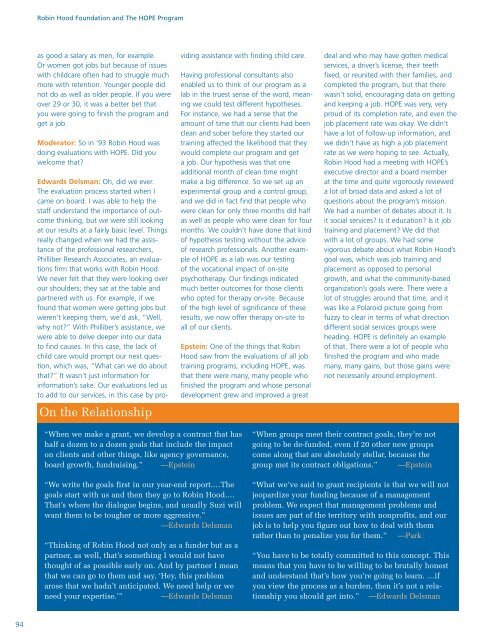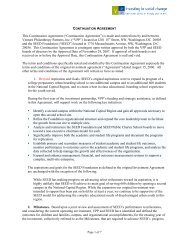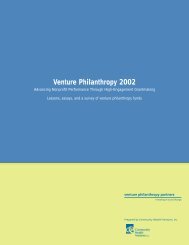Robin Hood Foundation and The HOPE Program - Venture ...
Robin Hood Foundation and The HOPE Program - Venture ...
Robin Hood Foundation and The HOPE Program - Venture ...
You also want an ePaper? Increase the reach of your titles
YUMPU automatically turns print PDFs into web optimized ePapers that Google loves.
<strong>Robin</strong> <strong>Hood</strong> <strong>Foundation</strong> <strong>and</strong> <strong>The</strong> <strong>HOPE</strong> <strong>Program</strong>as good a salary as men, for example.Or women got jobs but because of issueswith childcare often had to struggle muchmore with retention. Younger people didnot do as well as older people. If you wereover 29 or 30, it was a better bet thatyou were going to finish the program <strong>and</strong>get a job.Moderator: So in ‘93 <strong>Robin</strong> <strong>Hood</strong> wasdoing evaluations with <strong>HOPE</strong>. Did youwelcome that?On the RelationshipEdwards Delsman: Oh, did we ever.<strong>The</strong> evaluation process started when Icame on board. I was able to help thestaff underst<strong>and</strong> the importance of outcomethinking, but we were still lookingat our results at a fairly basic level. Thingsreally changed when we had the assistanceof the professional researchers,Philliber Research Associates, an evaluationsfirm that works with <strong>Robin</strong> <strong>Hood</strong>.We never felt that they were looking overour shoulders; they sat at the table <strong>and</strong>partnered with us. For example, if wefound that women were getting jobs butweren’t keeping them, we’d ask, “Well,why not?” With Philliber’s assistance, wewere able to delve deeper into our datato find causes. In this case, the lack ofchild care would prompt our next question,which was, “What can we do aboutthat?” It wasn’t just information forinformation’s sake. Our evaluations led usto add to our services, in this case by providingassistance with finding child care.Having professional consultants alsoenabled us to think of our program as alab in the truest sense of the word, meaningwe could test different hypotheses.For instance, we had a sense that theamount of time that our clients had beenclean <strong>and</strong> sober before they started ourtraining affected the likelihood that theywould complete our program <strong>and</strong> geta job. Our hypothesis was that oneadditional month of clean time mightmake a big difference. So we set up anexperimental group <strong>and</strong> a control group,<strong>and</strong> we did in fact find that people whowere clean for only three months did halfas well as people who were clean for fourmonths. We couldn’t have done that kindof hypothesis testing without the adviceof research professionals. Another exampleof <strong>HOPE</strong> as a lab was our testingof the vocational impact of on-sitepsychotherapy. Our findings indicatedmuch better outcomes for those clientswho opted for therapy on-site. Becauseof the high level of significance of theseresults, we now offer therapy on-site toall of our clients.Epstein: One of the things that <strong>Robin</strong><strong>Hood</strong> saw from the evaluations of all jobtraining programs, including <strong>HOPE</strong>, wasthat there were many, many people whofinished the program <strong>and</strong> whose personaldevelopment grew <strong>and</strong> improved a greatdeal <strong>and</strong> who may have gotten medicalservices, a driver’s license, their teethfixed, or reunited with their families, <strong>and</strong>completed the program, but that therewasn’t solid, encouraging data on getting<strong>and</strong> keeping a job. <strong>HOPE</strong> was very, veryproud of its completion rate, <strong>and</strong> even thejob placement rate was okay. We didn’thave a lot of follow-up information, <strong>and</strong>we didn’t have as high a job placementrate as we were hoping to see. Actually,<strong>Robin</strong> <strong>Hood</strong> had a meeting with <strong>HOPE</strong>’sexecutive director <strong>and</strong> a board memberat the time <strong>and</strong> quite vigorously revieweda lot of broad data <strong>and</strong> asked a lot ofquestions about the program’s mission.We had a number of debates about it. Isit social services? Is it education? Is it jobtraining <strong>and</strong> placement? We did thatwith a lot of groups. We had somevigorous debate about what <strong>Robin</strong> <strong>Hood</strong>’sgoal was, which was job training <strong>and</strong>placement as opposed to personalgrowth, <strong>and</strong> what the community-basedorganization’s goals were. <strong>The</strong>re were alot of struggles around that time, <strong>and</strong> itwas like a Polaroid picture going fromfuzzy to clear in terms of what directiondifferent social services groups wereheading. <strong>HOPE</strong> is definitely an exampleof that. <strong>The</strong>re were a lot of people whofinished the program <strong>and</strong> who mademany, many gains, but those gains werenot necessarily around employment.“When we make a grant, we develop a contract that hashalf a dozen to a dozen goals that include the impacton clients <strong>and</strong> other things, like agency governance,board growth, fundraising.” —Epstein“We write the goals first in our year-end report.…<strong>The</strong>goals start with us <strong>and</strong> then they go to <strong>Robin</strong> <strong>Hood</strong>.…That’s where the dialogue begins, <strong>and</strong> usually Suzi willwant them to be tougher or more aggressive.”—Edwards Delsman“Thinking of <strong>Robin</strong> <strong>Hood</strong> not only as a funder but as apartner, as well, that’s something I would not havethought of as possible early on. And by partner I meanthat we can go to them <strong>and</strong> say, ‘Hey, this problemarose that we hadn’t anticipated. We need help or weneed your expertise.’” —Edwards Delsman“When groups meet their contract goals, they’re notgoing to be de-funded, even if 20 other new groupscome along that are absolutely stellar, because thegroup met its contract obligations.” —Epstein“What we’ve said to grant recipients is that we will notjeopardize your funding because of a managementproblem. We expect that management problems <strong>and</strong>issues are part of the territory with nonprofits, <strong>and</strong> ourjob is to help you figure out how to deal with themrather than to penalize you for them.” —Park“You have to be totally committed to this concept. Thismeans that you have to be willing to be brutally honest<strong>and</strong> underst<strong>and</strong> that’s how you’re going to learn. …ifyou view the process as a burden, then it’s not a relationshipyou should get into.” —Edwards Delsman94






